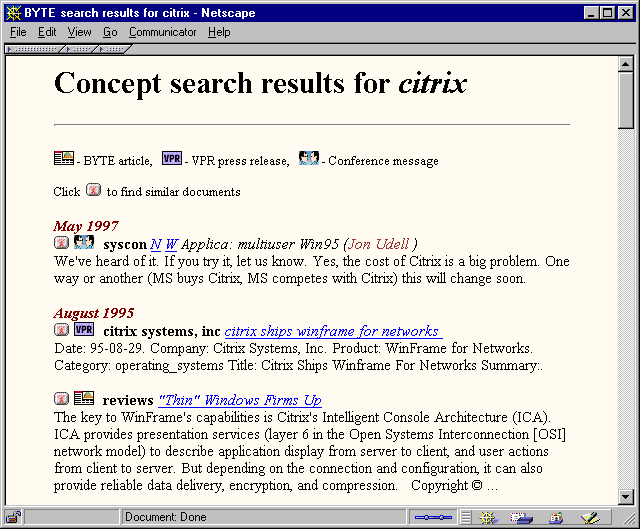

Phil Wainewright
|
Boy, does this ever bring back memories! I built a similar application, called the Virtual Press Room, for BYTE.com in 1995, and wrote a column about it. (There's still a Web page that gamely tries to search the VPR, on a server that CMP recycled five years ago.) Back then, it was cutting-edge to enable folks to cut and paste from their Microsoft Word press releases into a Web form, and then to publish that content for them. Nowadays, you'd think that would be passé. Why not just offer RSS feeds? But old habits are hard to break. As Phil discovered, there aren't yet many publicists doing RSS feeds. There are still quite a few, though, who are willing to do the cut-and-paste.
Phil writes:
This is all a bit of a departure for a content site, which according to conventional wisdom ought to be trying to suck in as much traffic as possible to its own pages. But I beg to differ. I think it's wrong to think of a website as a static destination. Better to think of it as a delivery hub, the point from which you disseminate information and services over the network on demand. All of this is part of a philosophy that I like to call "content-as-a-service". The Loosely Coupled website will be elaborating on that philosophy in the coming weeks and months, and in the meantime we welcome your comments and feedback on our services as they evolve.
+1, Phil! I particularly applaud the way your form invites contributors to categorize their entries in ways that make those entries more broadly useful. Press releases are a really interesting source of information, provided that you contextualize them. When you stop to think about it, the whole history of our industry is written on a series of press releases (and also, of course, on a bunch of T-shirts, coffee mugs, and mousepads). Why wouldn't we want to manage this data?
This click-to-enlarge screenshot shows how I used to do it on BYTE.com, circa 1997 :

Vendor information in context
|
And here's the column that explains how. Editorial content was clearly labeled as such. Ditto for user-contributed content (our newsgroups) and vendor-contributed content (press releases). Although it's slightly depressing to see that Phil was driven to the same data-capture solution that I resorted to 8 years ago, I'm nevertheless hopeful that we are, finally, on the cusp of change.
Sam Ruby today cites this eCommerceTimes story by Tiernan Ray:
In effect, the XML standard for structured Web data could be used as a uniform way to transform each tool's blog into another's, in order to hand off control. Not only would this avoid a knowledge disaster in the long term, but it would encourage blog sharing and collaboration in the near term.
Yes. Now, think about the tool used to write the press releases that I used to collect, and that Phil is now collecting. It's Microsoft Word. Eventually, people will figure out that it's easier to save an RSS item directly from Word 2003 (or, if you prefer, from OpenOffice or another XML-savvy tool) than it is to do the cut-and-paste.
That presumes, of course, that it is easier to do it. Don Box assures us that it will be:
I just got the WordML->RSS20+XHTML transform to work. As much as people bitch about how hideous WordML is, it's considerably easier to handle than XHTML + CSS, as the latter is not XML markup. [Don Box's spoutlet]
Cool! How about sharing? My transforms from beta 1 aren't working in beta 2, and I could use a jumpstart. So could the thousands of other people who have yet to be shown a compelling reason to use the XML features of Word 2003.
Former URL: http://weblog.infoworld.com/udell/2003/05/01.html#a677